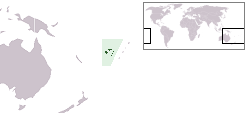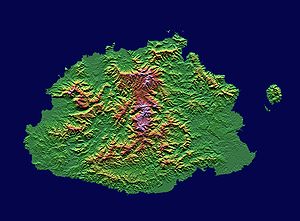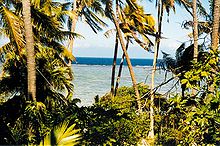Viti Levu
This article needs additional citations for verification. (September 2016) |
 Map of Fiji showing Viti Levu (one of its major islands) | |
 | |
| Geography | |
|---|---|
| Location | Pacific Ocean |
| Coordinates | 17°48′S 178°0′E / 17.800°S 178.000°E |
| Archipelago | Viti Levu Group |
| Area | 10,388 km2 (4,011 sq mi) |
| Area rank | 75th |
| Length | 146 km (90.7 mi) |
| Width | 106 km (65.9 mi) |
| Highest elevation | 1,324 m (4344 ft) |
| Highest point | Tomanivi |
| Administration | |
Fiji | |
| Division | Western Division and Central Division |
| Largest settlement | Suva (pop. 93,970) |
| Demographics | |
| Population | 740,000 (2022) |
| Pop. density | 55.83/km2 (144.6/sq mi) |
| Ethnic groups | Native Fijians (54.3%), ) (7.6%) |
Viti Levu (pronounced [ˈβitʃi ˈleβu]; lit. 'Great Fiji') is the largest island in the Republic of Fiji. It is the site of the nation's capital, Suva, and home to a large majority of Fiji's population.
Geology
Fiji lies in a
The oldest rocks on the island are those formed during the
Geography, economy and ecology


Viti Levu is the largest island in the Republic of Fiji — home to 70% of the population (about 600,000 people) — and is the hub of the entire Fijian archipelago. It measures 146 kilometres (91 mi) long and 106 kilometres (66 mi) wide, and has an area of 10,389 square kilometres (4,011 sq mi). Earthquakes and volcanic eruptions account for the somewhat rugged terrain of the island, which is divided into roughly equal halves by a mountain range that runs north to south. The centre of the island is forested and includes the nation's highest peak Mount Tomanivi (otherwise known as Mount Victoria), which rises to 1,324 metres (4,344 ft).
The eastern side of the island experiences heavy rainfall, particularly in the mountains, and is home to
The island is susceptible to the effects of climate change. It is estimated that the compound effects of sea level rise and storm surge may result in a temporary relocation of a relatively high numbers of the inhabitants of Viti Levu, predominantly the northern and western parts, with an exposure of up to 6.75% of the islands' population in the future.[4]
Localities


Viti Levu is home to the capital city of
Politics
Eight of Fiji's fourteen
History
Prehistory
Viti Levu is believed to have been inhabited longer than the island of Vanua Levu, which lies to its north. According to oral tradition, the first Melanesian settlers landed at Vuda Point and established Viseisei as Fiji's first oldest settlement. There is archaeological evidence contradicting this account.
Transportation
Ferry service, provided by the
Nausori International Airport is on the main island. It has service on 3 domestic commercial passenger airlines.
References
- ^ Greenbaum, D.; Bowker, M. R; Dau, I; Drospy, H; Greally, K. B; McDonald A. J. W; Marsh, S. H; Northmore, K. J; O'Connor, E. A; Prasad, R. S & Tragheim, D. G. (1995). "Landslide hazards in Fiji" (PDF). Technical Report WC/95/28 Rapid methods of landslide hazard mapping : Fiji case study. British Geological Survey. Retrieved 23 March 2011.
- ^ Provisional Geologic Map of Fiji. Suva: Fiji Geological Survey. 1965.
- .
- .
